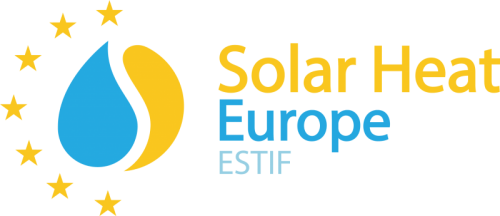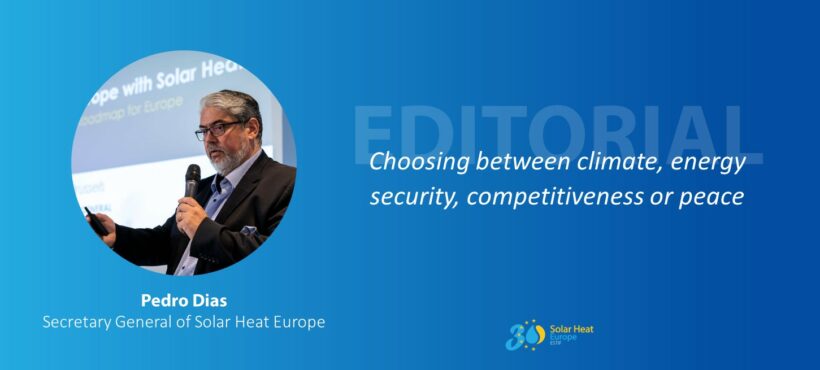Renewables are essential to the energy transition. If a faster move towards renewables would have happened, the current energy crisis would have been largely avoided. And more than that, European citizens would not be financing countries, in Europe as in the Middle East, whose actions are in confrontation with European values.
We cannot look the other way; we cannot ignore what brought us here.
February 2022 represents a milestone for the energy transition in Europe. The European dependency on fossil fuels, in particular Russian gas, placed Europe in a difficult situation. Russia has not only attacked Ukraine, but it also attacked the EU democratic values. And this is a war we will have to fight over this winter – the exploitation of the energy crisis by populists, ignited by misinformation and propaganda, exploiting the difficulties of those that struggle to pay their bills or fear about their jobs.
We need to look back and point the finger at the European leaders that could have done more. We have had serious warnings in recent years. Previous crises, also related to EU’s dependency on Russian gas and the tensions between Russia and Ukraine, occurred in 2009 and 2015. Europe had the chance to act but was clearly dragging its feet.
We can argue about the reasons behind this lack of action at European level. Be it the strength of the fossil fuel lobby, be it strategic mistakes in the relation between Europe (in particular Germany) and Russia, or the expectable inertia related to such a challenging task as the energy transition. Be it any of these or any other potential reason, the fact is that Europe faces an overwhelming crisis regarding energy security and energy affordability.
Solar heat is one of the most interesting examples of what was left undone.
This is a sector where products made in the EU represent over 90% of the sales in the EU market. This is a sector that has net exports. A technology with an extremely low environmental footprint and excellent indicators in terms of sustainability and circularity. And let’s not forget, it is not dependent on critical materials or supplies from risky suppliers and ‘geopolitical foes, such as Russia or China. On top of that, solar thermal provides energy at lower costs than other alternatives. Still, the solar thermal generation is one third of that predicted by member states for 2020.
Previous to the current energy crisis, solar thermal had already solutions that could compete with gas, with its levelised costs being lower than the gas price at the time. Still, costs represented one of the main barriers for a faster deployment:
- for the domestic sector, because solar thermal represents a much upfront investment to fossil fuel-based alternatives or direct electric heaters;
- for industrial process heat, because clients often demand a payback between 3 to 5 years.
With the current increase in energy prices, one could think that the situation would dramatically change in favour of renewables, including solar heat.
In fact, the European Commission showed good intentions regarding the need to speed up the deployment of renewables. Though they were faced with a serious obstacle: the need for fast solutions that can have an enormous impact right away.
Such options just don’t exist! They would exist if action had been decisive in the aftermath of 2009 or 2015. But they cannot appear by magic in a few months.
Preparing for the storm
The best alternative for Europe is renewable energy and renewable heat, in particular.
These sources, essential to address what is inherently a heating crisis, take months or even years to implement with the current framework. Some initiatives, like those proposed by the European Commission within REPowerEU regarding permitting or the solar mandate, can make a difference, also for the deployment of large-scale solar thermal or rooftop solar thermal. But the political discussion around these initiatives at the European level alone takes many months, not to mention the time that will be needed for the transposition at the national level, and finally, implementation.
We cannot compensate for mistakes from the past with current goodwill. The slow energy transition process cannot be stepped up from one week to the next.
And it does not help that, in the panic of looking for alternative solutions for this winter, EU Member States and utilities have tried to ensure supply at any costs in a clear seller’s market. We still have to see a full assessment of the future implications of the contracts that have been pursued in rush. The length of these commitments as well as the costs, not only in terms of supply but also in terms of required investment in infrastructure are still to be seen.
So, what can we do? Obviously, we need to prepare for the storm. Nevertheless, while weathering the storm, we must look beyond the deluge. We need to start acting decisively and strategically.
Are we giving clear signals?
One of the ways is by giving clear signals to consumers, domestic or corporate, that we are moving away from gas, whatever the origin. These can be price signals, regulatory or fiscal, or a mix. But these signals need to speak strongly and clearly!
In addition, we need to pursue a fast-paced change, based on a combination of push and pull policy measures. This means that the transition must be enforced by regulatory measures but softened by financial support. First and foremost, to those affected by energy poverty but it cannot be limited to the former.
In a period where financing costs are on the rise, EU and Member States need to ensure that consumers have access to financing at extremely low costs, in order to ensure liquidity that empowers them to invest in renewables which, in spite of the higher upfront cost allow for incomparably lower lifetime costs.
Heat is the elephant that can crush us or give us a back ride
We need to treat this crisis for what it is: a heating crisis!
It is essential to provide decentralised renewable heat solutions, in buildings, in cities. We need to place heat at the core of our energy strategies. Or rather, renewable heat!
That is not an easy feat. Heat being a local topic is mostly felt by local powers and remains far from the corridors of Brussels. Both the European Commission and the member states have competencies in regulating the electricity and gas markets. This means that they have the expertise and the tools to act on those sectors. This also means that lobbies related to those sectors spend millions influencing their actions. And this creates a centripetal force that makes the energy debate to converge around electricity and gas.
We need to break this vicious circle and bring renewable heat into the discussion. Because, let’s face it, electricity and gas, in this energy security and energy affordability crisis, have been a large part of the problem rather than the solution.
And being renewable heat essential to develop a sustainable, affordable, and competitive energy system, one should assume that Europe would have a strategy for it, right? Well, putting it mildly … not yet!
The fact is that we don’t have to choose between climate, energy security, competitiveness, or peace. They are all part of the same equation. And we know the formula. We just need to put our minds and will into solving it.


Leave a Reply